Challah done two ways from the same dough (Jewish New Year’s loaf AND a braided challah)
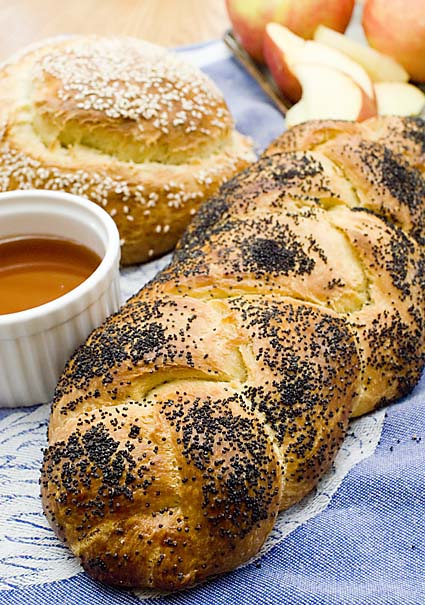
It’s Jewish New Year (tonight) and the traditional loaf, a round, turban-shaped one (round=continuity of life) took a back seat in this photo– so I decided to do a challah extravaganza and go through both shapes, which are easy once you see how they’re done. Here’s the turban from a little closer:
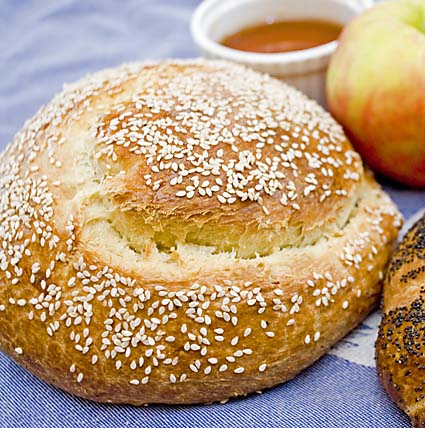
They’re both made from the same dough but the New Year’s turban always has raisins or other sweet fruit (to symbolize a sweet new year)– we’ll roll them into the dough so you don’t have to mix up a special one. First, roll out some pre-mixed challah dough from page 296 of the book (purchase by clicking here). You can even make it with brioche dough if you’re looking for something richer, but the less rich dough is more traditional. Roll a grapefruit-sized piece of dough as in Zoe’s post on raisin bread, sprinkle a handful of raisins, roll it back up, and and you’ll get something that looks like this:

Thin out one end by rolling and stretching at the end that’s going to be thinned:
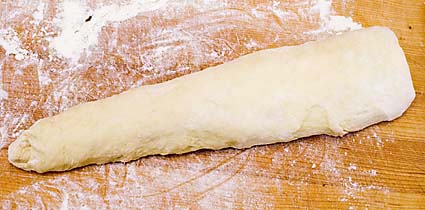
Starting with thick end in the middle, wind the thinner end around it and finally, tuck it underneath to seal:
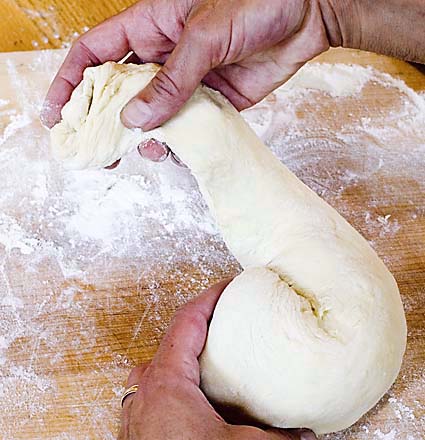
Put the loaf on a cookie sheet prepared with shortening or parchment paper, or my favorite these days, a silicone pad, which can go straight into the oven with or without the support of a cookie sheet. Brush the loaf with egg wash and sprinkle with sesame seeds:
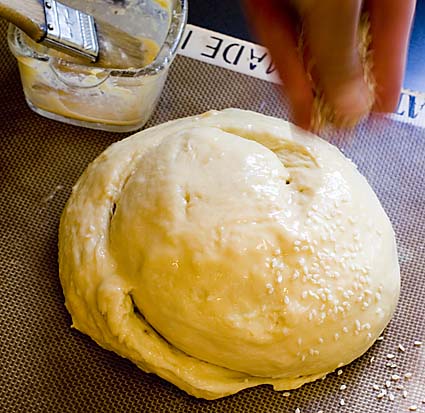
Allow the loaf to rest for an hour and 20 minutes, then bake at 350 degrees F (175 degrees C) for about 30 minutes, until nicely browned (larger loaves will take more time). Here’s the finished turban-shaped loaf again, ready for eating with apples and honey for a sweet new year:

But if you want to make the traditional braided challah (without raisins), here’s how to do it: First form a grapefruit-sized ball and cut it into thirds with a knife or dough scraper.
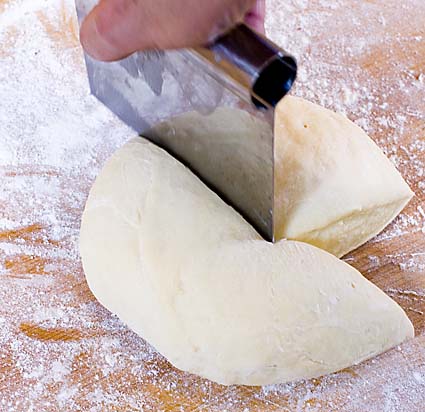
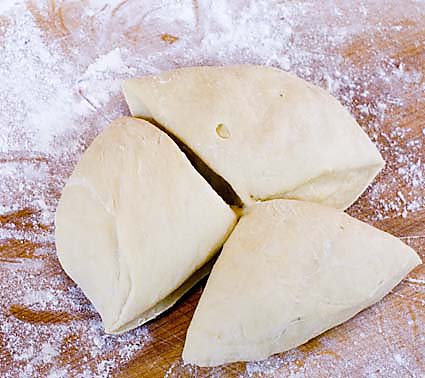
Gently roll and stretch each piece, dusting with flour so your hands don’t stick to it, until it’s about an inch thick. You may need to walk away and let the dough relax for five minutes so it won’t resist your efforts. When you’re done, lay them straight on a lightly floured work surface:

The key to a beatiful braid is to start from the middle, not from one of the ends. Pull the strand farthest from you over the middle strand and lay it in the middle– that’s never changes, you’re always pulling outside strands into the middle, and you never move the middle strand:
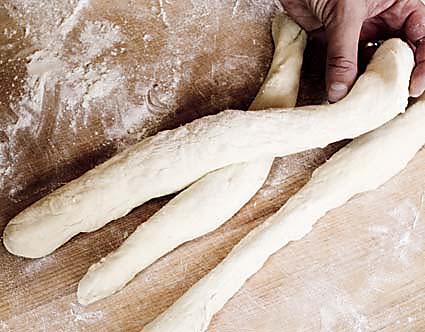
Now pull the closer strand over to the middle:
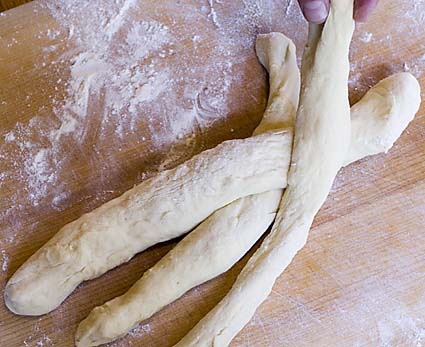
Keep going, alternating outer strands but always pulling it into the middle:
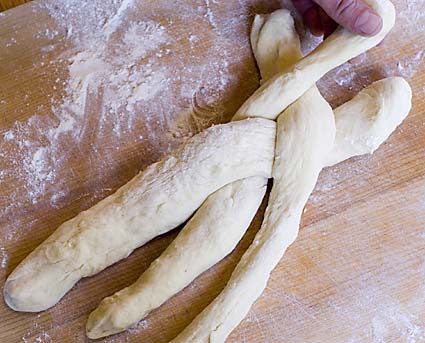
When you get to the end, pinch the strands together:

Now (and this is the fun part), flip it over so the loose strands fan away from you:

Start braiding again by pulling an outside strand to the middle, but this time start with the strand closer to you:

Don’t worry if things look a little mis-shapen, you can nudge it back into shape at the end. Braid to the end again, and pinch together, lay it on a cookie sheet prepared with shortening, parchment, or a silicone pad, and paint it with egg wash:

Using my fingers, I’ve gently nudged the loaf into a more symmetrical shape before painting the egg wash:
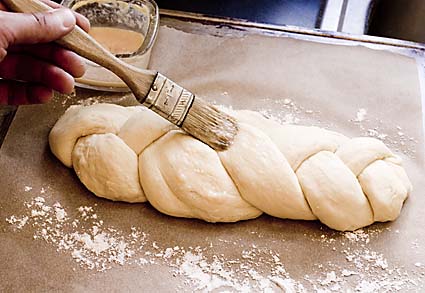
Now sprinkle with poppy seeds:
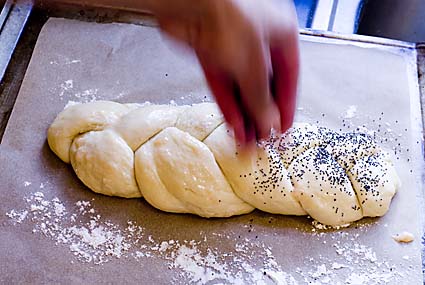
Allow the loaf to rest for an hour and 20 minutes, then bake for about 30 minutes at 350 degrees F (175 degrees C), and the colors create a beautiful contrast:

Follow us on Twitter.com!
This challah bread is amazing! My family is hooked on it. We have even made a longer braid and formed it into a wreath which looks stunning.
What gorgeous breads! I love Challah so much!
Cheers,
Rosa
Thanks Trish and Rosa. Trish, how are you joining the ends of the braid to form the wreath? That’s always a bit tricky and if you have a great way to do it I’m sure readers here would love to know. Jeff
I attempted to make a Challah for Rosh Hashanah dinner yesterday by cutting your Challah dough recipe in half – with DISASTROUS results! The dough was like soup after a couple hours in the refrig, so I panicked and added a bunch more flour. It still didn’t seem usable so I threw it back in the refrigerator and instead made a fast bread-machine egg dough, in order to have something ready for the evening meal! (It looked lovely but did not have the wonderful flavor of your Challah) Do you know why the dough might have turned out so loose? I have never made a half recipe before..(and I checked and rechecked my division!)Perhaps it needed an overnight in the refrigerator after the initial proofing instead of just a couple of hours to chill? Unfortunately I added flour before I could test out that theory. I’m curious how the dough I saved is going to handle now – I hope to try it out tomorrow. I was so disapointed, though, as I had great success when I made the full Challah recipe previously.
That looks amazing; happy Rosh Hashanah!
I’ve posted before about how much my husband I are enjoying our AB5 bread, but I thought you might enjoy Jon’s latest quotes:
“how did we ever survive without this”
and
“If I hadn’t already, I’d marry you just for this”
and
“om nom nom nom”
(i.e., cookie monster noises)
My next experiment is going to be to try to make kimmelweck rolls. Those are sort of like kaiser rolls with caraway seeds and salt on top. They are used to make roast beef sandwiches with horseradish (“beef on weck”) in Buffalo, where I grew up, and I miss them!
What dough/method would you recommend to make a kaiser roll clone?
Oh, I forgot to mention: I got great results from the beginning, but I bought some King Arthur flour a few weeks ago, and got *GORGEOUS* loaves. I don’t even let them rise for the full 40 minutes (just for the 20 minutes or so it takes the oven to pre-heat) and I still get great oven spring.
Di: I’ve divided that recipe many times, and always got the same result as the full recipe. I can’t think of any other explanation other than a measurement error. The slightest distraction makes me lose count. The dough with added flour should work fine but let us know here if it doesn’t.
Jess: Thanks for the quotes, what fun to read those. If you want a soft kaiser roll, do the Soft American-Style White Bread, or the Buttermilk Bread. Or even challah. If you want something crisp, use any of our lean doughs– the basic Master should work, or Light Whole Wheat. Jeff
wow. striking! i love challah
Just saw your bread on Mary’s blog. Can’t wait to try them out! Looks delicious.
Hi Candy: Maybe I’m being thick, but where is Mary’s blog? Jeff
Jeff, I’m Mary and you stopped by my sight earlier today – I’m the Limpa bread lady. I wanted to tell you how beautiful this Challah looks. I think I’ll give it a try. I have braiding instructions somewhere around here. Happy New Year.
Thanks Mary! Scroll up to see our braiding instructions. Jeff
Jess who used King Arthur flour for gorgeous loaves — did you stick to the recipe as is, or did you adjust the flour amount at all? Thanks!
I have made this challah several time with wonderful results. I also used the same dough to make wonderful cinnamon rolls, and a little brioche….I love that the challah has “strands”…just a beautiful dough…I will try the round one for Yom Kippur!
L’Shana Tova!
Thanks Jazzy, and Shana Tova to you too. The idea in the book was to give people two ways to do enriched dough, basically, and enriched version (challah) and super-enriched (brioche).
You can do the round turban, which is traditional, or just a simple ball for Yom Kippur.
Thanks, Jeff
I finally got my book and made the Challah first thing. LOVED IT. See it here if you like https://eclecticpegasus.blogspot.com/
It is so, so tasty. And pretty too. I thank you guys so much to help us “regular people” have daily fresh baked bread. I thank you and my family thanks you.
Hi Tracy: Thank you for visiting, and for making our stuff! Your challah pix are beautiful, great job. Jeff
I came here for the first time and have gone through many of your mouthwatering posts already.
I have heard a number of times about this book of yours. I’m quite curious. But, I would like to know one thing: can one use this recipe for whole wheat (partly or 100%)breads as well? Thanks!
Hi PG, thanks for stopping in. Our book has a 100% WW loaf (p. 76), and our next book will have more (Healthy Bread in Five Minutes a Day is the tentative title). But you can’t just substitute out WW flour for AP flour in our recipes. WW flour absorbs more water so the liquids must be increased (you can experiment on your own, of course).
50/50 WW/AP is a much easier ratio to work with when you’re starting out, or even our Light Whole Wheat (page 74).
But the new book should be out 12/09! Thanks, Jeff
This is just an idea to try for Jeff or Zoë, or somebody with a panini press. I checked out a book from the library called Panini Express, getting more ideas for panini fillings — I have made a number with my Artisan Bread, also tend to make the ends of my dough into rolls.
Anyway — he presents some breads there at the beginning. I was intrigued with one shown. He used an olive oil type wet dough, rolled out like smallish pizza dough — then baked it right in the panini press. This made a nice crimped flatbread. Although he then put two together and made a panini, I thought might be even more interesting as open face sandwich or add the toppings as a small instant pizza and bake or broil for a minute. (He suggested these, too.)
Thanks Linda… I’m glad to hear that this works. I’m not surprised, because we do something similar with the naan (page 173). If you roll our wet dough thinly, it will bake through on a cast-iron or other hot surface without benefit of oven.
I don’t have a panini press– only question is whether the pressure would prevent the flatbread from rising and leaving it a bit dense– but it sounds like yours are working fine. Jeff
So Bread Top Secret !
Dear Jeff,
I’ve bought the book for 2 month, before I learn this secret ingredient, my bread always become very HARD like a rock after few hours, no matter which dough I made.
Japanese has invent an secret ingredient to let their bread become soft, it’s named “YU- SHU” (Warm dough)[汤种],it’s just [flour + water + 60degree celsius=YU-SHU].
1. flour 1:5 water
—if u put 100g of flour, then u need 500g of water.
2. Stir it together using 65 degree celsius fire, very small fire, don’t let it boil.
3. Stir until it become sticky, and can see the line pattern when u stir.
4. Let it cool down before u mix with dough ingredients, u can put into fridge for days but throw away when it become gray. Then it’s done!
4. Add 20% of Yu-Shu into your dough ingredients and mix together. If u mix a 500g dough, add 100g of Yu-shu.
Now you can get a Soft bread!
I’ve tried to add Yu-Shu with the Oliver Dough (Pg134) and get a soft bread,
the bread still soft untill next day!
Sorry for my poor english~
but its really works!!!
Try it if u want to do a soft bread!
Lulu
Malaysia
Thanks Lulu, I’m honored that you’re visiting us all the way from Malaysia again.
I can’t quite figure out why this should soften the crust, but I guess I better try it. It seems that something that wet would make our dough overly loose at that ratio. It could be that you’re getting such a high-moisture result, that that alone keeps the crust soft.
In our books, the usual approach to getting a soft crust is to use shortening (oil, butter, or other fat) in the dough.
My overall advice of course, would be to only make as much bread as you can eat on the first day! Jeff
I made my first half-batch of challah bread recently. Truthfully, I expected a failure. I’m not a very good baker. But it was outstanding, as all your breads have been.
What amazed me was how easily the dough worked. Inspired by the cinnamon-raisin loaf, I adapted it by replacing raisins, which I dislike, with chocolate chips.
Oh man, oh man, oh man!
Thank you Martha! My kids want to be invited over to your house, they’d want chocolate chip baguettes! Jeff
I emailed this question in…and figured I’d add question and answer to the comments page…
I bought a dough rising bucket from King A’s web site. I would have thought that the lid would have been vented. You are firm on not having an air tight lid while storing…so I should ditch the lid and lightly cover with plastic wrap? I admit that I snapped the lid but then I noticed these big air bubbles forming….so I cracked it open again.
Jeff’s reply…
There’s an easy solution— For the first 24-48 hours, just keep the lid cracked very slightly. My lids aren’t vented either, and this is how I do it. The lid is much easier to deal with that plastic wrap.
Thanks for posting here too Sloane, great to hear from you. Poke around, there’s quite a lot of content in our site to enhance the book. Jeff
I tried the challah recipe for the first time today. I messed up and brushed the shaped loaves with egg and sprinkled with seeds before I let them rest and rise. Will I have bad results now?
No, Sandra, the result will be just fine. I can’t think of any reason why this would cause a problem. Maybe the color or finish will be a little different.
Will you let me know here? Jeff
Jeff , thanks for answering my silly question. I ended up with beautiful loaves! I did have a little issue with them getting a little browner than I wanted . The turban loaf sort of over expanded on top and split a little so the shape is not perfect. The braided loaf is picture perfect. I was a little nervous about the braiding , but your instructions and pictures were so helpful! I am bringing them to a break the fast dinner tonight, so I will have to wait to see how they taste.
By the way , I love the book !
Your welcome Sandra, and Shana Tovah. Hope your guests enjoy the bread, and thank you for trying our method. Jeff
Hello! Never tried or tasted Challah, but I am now wondering what happens if you change honey to brown sugar or ordinary caster sugar? Would the measurements be the same? Would the taste of original Challah change significantly?
Hi TiV: You can try substituting the sugars for the honey 1:1– that’s what I’d do. If you were really keeping score, you’d very slightly decrease the water in the recipe, maybe a tablespoon or two.
The flavor will change in a subtle way– see what you think. Jeff
I made this Challah a couple a weeks ago and I could eat it everyday! It is so good.
I’ve only had one failure with all of the breads I’ve made. I had a small bit of basic bread recipe left over and thought I spread some nutella in it. It leaked out all over and burned. It was so gross.
But… how ’bout that Nutella on bread that’s already baked?
Jeff
I made challah many ways, but this recipe is definitely the most tasty. The recipe calls for 1 lb of dough, but I used 2 lbs, and even then the result is an average sized loaf. Now I have two issues: 1. The baking time is about 50 minutes at 350. (I’ve check my oven and it’s off just 2 degrees.) The internal bread temp is 190, just what it should be. So why so long?
2. I can never get a smooth, glossy crust with this dough and with the egg wash. The challah comes out looking rustic, as does the master recipe breads. Should the egg was just use the yoke, rather than the whole egg?
I tried this both ways…butter and oil and loved the flavor of both.
On a broader note…I love your book and my daughter borrowed it, loved so many recipes, she ran out and bought her own copy.
Thanks Harry, what a great compliment. You’re doubling the size of the loaf we make (admittedly a small one). We say in the book, “…larger loaves will require adjustments in baking time.” Maybe we should have said “increased” or even increased dramatically. What you’re seeing is just what I’d expect. About the glossy surface, you could try yolk-only, or try another trick. Paint the egg wash right after shaping, to let it dry. See if that helps. If not I’ve got some other ideas so write back with the result if you have time.
Ruth: Thank you for helping us get the word out on the book! Jeff
I have never made bread. However, I started making your challah in August this year and this has absolutely been my kids’ favorite. I then shared it with friends and they loved it. A Jewish friend, in fact, asked me to make 10 loaves for their son’s Bar Mitzvah last Saturday. It was a hit! I love, love your book!!!
Elizabeth: I can’t thank you enough for your sweet note. Ten challahs, you are so ambitious— I’m so glad they were a hit because it gets challenging to mass-produce them (I feel obligated to drop some Yiddish into this conversation– Mazal Tov!). Thanks for telling us this story and come by anytime you have questions. Jeff
I did not dare to mass produce this since I had not enough experience to speak of. Instead, I made 4 batches of the basic recipe (getting 3 loaves for each – the extra 2 loaves were shared with other friends). You can imagine me with the 4 buckets and adding one ingredient at a time the night before. Adding and counting the flour was the trickiest part. Then, I was up at 4 a.m. to begin shaping, resting and baking the loaves.
Am not familiar with Jewish traditions so when my friend asked me to make it for the reception, I assumed it was just to be served as a side. I was pleasantly surprised when she thanked me in front of their 150 guests and proceeded with the breaking and sharing of the challah.
BTW, I gave a copy of your book to my Jewish friend (and she is an excellent cook and baker) but she says she can’t replicate the challahs I make. Hmmm …
Elizabeth, you are a good friend! 4 AM?
Were you an experienced baker before this. Getting a perfect braid takes a bit of practice. I bet the flavor she’s getting is good.
Jeff, yes I’d like to think I am a good friend. Her daughter will have a Bat Mitzvah in 2 years time — I hope I will not be asked again because it took a lot of effort.
Nope, I am not an experienced baker at all. I am good at braiding only because I used to braid my daughter’s hair.
Have a great Tuesday!
This is probably too late to be helpful, but to answer Linda’s question: I followed the recipe verbatim when I got gorgeous loaves with the KA flour, EXCEPT that I weigh the flour, rather than measuring.
I’ve really enjoyed making the breads in your book. All have been spectacular. One question, I made Challah for Thanksgiving. After braiding I let it rest on the counter for an hour and a half then brushed with egg wash and baked. The parts that were egg washed looked great but due to the spring in the oven the majority of it looked rather pale. It still tasted amazing but how can I get it to be uniformly brown?
Judy: A longer counter rise would shift some of the rising to the counter, so proportionally there’d be less oven spring.
But I kind of like that color contrast!
Another idea would be to use convection if you have it in your oven; that promotes browning. Jeff
Thank you, Jeff. I’ll give that a try.
Hi, I wanted to break my dependence on our bread machine and so bought your book. I wanted to try the challah, but wanted a larger loaf, so I made only a half-batch of dough, followed the instructions as best I could, and then put the 2 lb. loaf in the oven. After about 35 minutes, the crust was quite brown (and beautiful!), so I took it out of the oven. The outer ends were utterly delicious, but in the middle of the loaf, the dough was still raw.
Any suggestions for how I can get the whole 2-lb. loaf to bake longer? Go down to 325 degrees? It’s a superb recipe, so I really want to make it again, but don’t want to scoop out raw dough in the center of the middle part of the bread (which wasn’t appreciably higher than the ends).
Thanks for your help. I bought the book partly on a recommendation that the breads are fantastic and partly because someone told me that the authors actually answer questions. Wow!
Welcome to the site Mickey. Yes, we do in fact answer all the questions!
I’m really thinking that your oven thermostat is off and you need to check with a reasonably-priced oven thermometer ($15; we have one in our Amazon Store connection on the home page, but it doesn’t matter where you get it). It seems like you’ll get over-browning before the center’s set only if the oven is too warm, and that’s my best guess.
Two-pound loaves will take considerably longer than 1-pounders, so it’s possible that you just need to bake closer to 45 minutes. But you don’t want the crust to burn.
I’d start by checking the temp. Another option is to see what happens when you make a one-pounder.
Let us know? Jeff
Just finished my 4th boule, it is lovely. Will have it with pea soup. Yum, winter food and baking warms the house. Thank you for your generous sharing of your creative skills. My copy of your book is coming soon and I have enthusiatically recommend you to our local, independant book store.